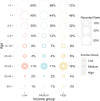Estimated incidence of respiratory hospitalizations attributable to RSV infections across age and socioeconomic groups
- PMID: 36280891
- PMCID: PMC9592130
- DOI: 10.1186/s41479-022-00098-x
Estimated incidence of respiratory hospitalizations attributable to RSV infections across age and socioeconomic groups
Abstract
Background: Surveillance for respiratory syncytial virus (RSV) likely captures just a fraction of the burden of disease. Understanding the burden of hospitalizations and disparities between populations can help to inform upcoming RSV vaccine programs and to improve surveillance.
Methods: We obtained monthly age-, ZIP code- and cause-specific hospitalizations in New York, New Jersey, and Washington from the US State Inpatient Databases (2005-2014). We estimated the incidence of respiratory hospitalizations attributable to RSV by age and by socioeconomic status using regression models. We compared the estimated incidence and the recorded incidence (based on ICD9-CM) of RSV hospitalizations to estimate the under-recorded ratio in different subpopulations.
Results: The estimated annual incidence of respiratory hospitalizations due to RSV was highest among infants < 1 year of age with low socioeconomic status (2800, 95% CrI [2600, 2900] per 100,000 person-years). We also estimated a considerable incidence in older adults (≥ 65 years of age), ranging from 130 to 960 per 100,000 person-years across different socioeconomic strata. The incidence of hospitalization recorded as being due to RSV represented a significant undercount, particularly in adults. Less than 5% of the estimated RSV hospitalizations were captured for those ≥ 65 years of age.
Conclusions: RSV causes a considerable burden of hospitalization in young children and in older adults in the US, with variation by socioeconomic group. Recorded diagnoses substantially underestimate the incidence of hospitalization due to RSV in older adults.
© 2022. The Author(s).
Conflict of interest statement
VEP has received reimbursement from Merck and Pfizer for travel expenses to Scientific Input Engagements on respiratory syncytial virus. DMW has received consulting fees from Pfizer, Merck, GSK, Affinivax, and Matrivax for work unrelated to this manuscript and is Principal Investigator on research grants from Pfizer and Merck on work unrelated to this manuscript. ZZ is expected to receive consulting fees from Pfizer. All other authors report no relevant conflicts.
Figures




References
-
- Shi T, McAllister DA, O'Brien KL, Simoes EAF, Madhi SA, Gessner BD, Polack FP, Balsells E, Acacio S, Aguayo C, et al. Global, regional, and national disease burden estimates of acute lower respiratory infections due to respiratory syncytial virus in young children in 2015: a systematic review and modelling study. Lancet. 2017;390(10098):946–958. doi: 10.1016/S0140-6736(17)30938-8. - DOI - PMC - PubMed
-
- RSV Vaccine and mAb Snapshot. https://path.org/resources/rsv-vaccine-and-mab-snapshot/.
-
- Single-Dose Nirsevimab for Prevention of RSV in Preterm Infants. The New England journal of medicine 2020, 383(7):698. - PubMed
-
- Zheng Z, Pitzer VE, Warren JL, Weinberger DM. Community factors associated with local RSV epidemic patterns: a spatiotemporal modeling study. medRxiv 2020:2020.2007.2006.20144345.
Grants and funding
LinkOut - more resources
Full Text Sources
Medical

